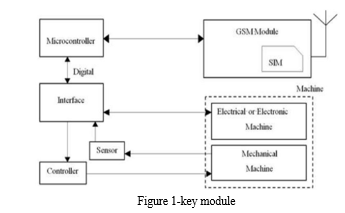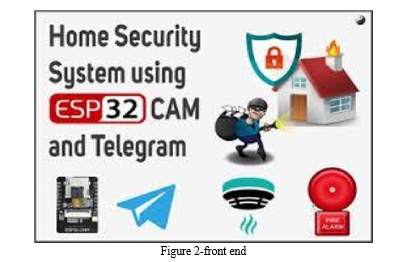Ijraset Journal For Research in Applied Science and Engineering Technology
- Home / Ijraset
- On This Page
- Abstract
- Introduction
- Conclusion
- References
- Copyright
Home Security System Using IOT: A Research Paper
Authors: Mr. Ayush G Ingole
DOI Link: https://doi.org/10.22214/ijraset.2024.62773
Certificate: View Certificate
Abstract
The integration of Telegram and ESP32 in a home security system represents an innovative approach to enhancing home safety and surveillance. This project presents a comprehensive framework that leverages ESP32, a low-power microcontroller, and the Telegram messaging platform to create a cost-effective and efficient home security system. The ESP32 is utilized to interface with various sensors and cameras, collecting real-time data related to home security. This data is then processed and sent to a Telegram bot, enabling homeowners to receive instant alerts and monitor their home’s security remotely. The system offers a reliable and convenient solution for individuals seeking to enhance their home security through smart technology using an OTP to the user. The integration of Telegram provides a user-friendly interface for real-time communication and control, making it accessible to a wide range of users.
Introduction
I. INTRODUCTION
IoT or Internet of Things refers to the network of connected physical objects that can communicate and exchange data among themselves without the need of any human intervention. The formal definition of IoT as the "Infrastructure of Information Society" aptly captures its significance in today's interconnected world. IoT indeed facilitates the collection of data from diverse sources, ranging from humans and animals to vehicles and household appliances. This capability to integrate various mediums into a cohesive network underscores the versatility and potential of IoT. Moreover, the concept's evolution since Peter T. Lewis's mention in 1985 highlights its longstanding presence in discussions surrounding technology and connectivity. The exponential growth of connected devices, surpassing 12 billion as of your last mention, demonstrates the widespread adoption and integration of IoT solutions across industries and domains. However, it's essential to note that while IoT utilizes the Internet infrastructure for communication, it transcends mere connectivity. By embedding objects with electronic hardware, sensors, software, and networking capabilities, IoT enables these everyday items to interact and exchange data autonomously, without direct human intervention. This distinction underscores IoT's transformative potential in reshaping how we perceive and interact with technology in our daily lives. As for the projected figure of 50 billion connected devices by the end of 2020, it's worth considering that such estimates are subject to revision based on technological advancements, adoption rates, and other factors influencing the IoT landscape. Regardless, the overarching trend points towards a continued proliferation of IoT devices, further embedding them into the fabric of our society and economy.
II. LITERATURE SURVEY
- Central Controller-based Home Automation System: The concept of a Central Controller-based Home Automation System presents both opportunities and challenges in the realm of home security and automation.
- Centralized Control: By centralizing control nodes for multiple homes, efficiency in management and monitoring can be achieved. This setup allows for easier coordination and management of various home automation and security functions.
- Scalability: The system can be scaled based on the number of homes in a locality, making it adaptable to different community sizes and needs.
- Real-Time Monitoring: Systems like SmartEye offer real-time monitoring capabilities, allowing homeowners to keep track of their property remotely via live camera feeds.
- Remote Access: With the integration of technologies like GPRS and Bluetooth, homeowners can access and control their home automation systems remotely using their mobile devices, enhancing convenience and accessibility.
- Challenges: Privacy Concerns: Centralized control means that a single entity has access to a wealth of personal data from multiple homes. This raises serious privacy concerns, as intimate details about individuals' daily lives could be exposed without proper safeguards.
- Cost and Maintenance: Implementing such a system requires a considerable number of homes in a locality to be cost-effective and maintainable. This could pose challenges, particularly in areas with sparse population density.
- Complexity: Central controller-based systems can be complex to implement and manage, requiring robust infrastructure and technical expertise. This complexity could result in higher installation and maintenance costs.
- Security Risks: Centralized systems are more vulnerable to cyber threats and hacking attempts. Ensuring robust security measures is crucial to prevent unauthorized access and protect sensitive data. In summary, while Central Controller-based Home Automation Systems offer significant benefits in terms of centralized control, scalability, and remote access, they also present challenges related to privacy, cost, complexity, and security. Addressing these challenges requires careful consideration of privacy regulations, robust security measures, and efficient system design and implementation.
III. PLANNED SYSTEM
The block diagram is shown in Fig.

In the above diagram, we have interfaced ESP32 with the motor which will control the motion of the door. The motor will rotate clockwise to open the door and will rotate anti-clockwise while closing the door. The door will be operated with the help of Telegram. The user should send a predefined code to open the door, the door will be open if the code is correct, or it send the notification to the Owner after 3 attempts. And door will shut till the owner sends the code. Once the user have sent the valid code the name of the user will be sent to the Owner so that the Owner will get the idea who is there in the house.
IV. SYSTEM ARCHITECTURE
Internet or IP protocol-based communication has become a prevalent choice in home automation systems for several compelling reasons. The Internet for communication in home automation systems offers numerous benefits, including scalability, accessibility, availability of hardware and network, high bandwidth, low communication cost, and ease of connection. These advantages make the Internet a preferred choice for integrating smart devices and enhancing the functionality of modern homes. Leveraging the Internet for accessing and controlling home automation systems offers a seamless and user-friendly experience that aligns with the needs and expectations of modern homeowners. Its ease of use, convenience, affordability, flexibility, and lack of additional technology requirements make it an attractive choice for enhancing the functionality and comfort of smart homes. Integrating home automation features into commonly used devices such as laptops, smartphones, PCs, and tablets represents a natural and intuitive progression for several reasons.

V. SYSTEM OVERVIEW
The research in home automation systems utilizing SMS communication offers various approaches to enhancing security and remote control capabilities.
- Alheraish: This proposed system utilizes SMS for detecting illegal intrusions and controlling lights in the home. It detects intrusions by monitoring the state of the home door using LED and infrared sensors. Users can change the door passkey and control lights remotely via SMS from registered mobile numbers.
- M.S.H Khiyal et al. (SMS-based Wireless Home Appliance Control System - HACS): This system enables homeowners to control home appliances through SMS messages from preset registered mobile numbers. Only messages from legitimate mobile numbers are acknowledged. In case of intrusion, the system alerts the owner through SMS.
- U. Saeed et al.: Their SMS-based home automation system incorporates a Java application on the user's phone. Legitimate users log in to the app with their credentials and select the desired building, floor, room, or device to control via SMS. The system employs a 4-digit passkey and facial recognition for security. Homeowners receive alerts on their mobile phones regarding unusual sensor state changes, allowing them to react via messaging or a web interface. This redundancy ensures continuous access to the home, even if one communication method fails. These research efforts highlight the versatility and practicality of using SMS communication in home automation systems, particularly in enhancing security measures and enabling remote control capabilities. By leveraging SMS, homeowners can conveniently monitor and manage their homes using mobile devices, ensuring peace of mind and flexibility in home automation management.

VI. RESULT
After using the Telegram BOT I was able to control and monitor the aplliances which I connected and could see the devices and appliances turning off and on without failure. It is very efficient system without the fear of any suspicious activity happening within our homes, in short we can rely on this system as it is very easy, effective and convenient to use. In this system we can observe seamless and effortless use of technology and its limits which can contribute in total well being of a Modern Society and makes lives as easier as possible.
VII. FUTURE SCOPE
The future scope of home security systems based on ESP32 technology and integrated with the Telegram app is incredibly promising. This innovative combination offers a wide range of possibilities for enhancing home security and automation. Users can expect seamless remote monitoring and control of their home security devices directly from their smartphones through the Telegram app. Real-time alerts, customizable security settings, and integration with various smart devices will empower users to effectively protect their homes from potential threats. As advancements continue, features such as biometric authentication, machine learning algorithms for anomaly detection, and scalability for expanding the system's capabilities will further enhance security and user experience. Moreover, emphasis on energy efficiency, data privacy, and affordability ensures that these systems remain sustainable and accessible to a broader audience. In essence, the future of ESP32-based home security systems integrated with the Telegram app holds great potential for revolutionizing how we safeguard our homes and loved ones.
VIII. ACKNOWLEDGMENT
I extend my sincere appreciation to the individuals and institutions whose contributions have made this research possible. Firstly, I thank the researchers and developers in the fields of artificial intelligence, Internet of things(IOT), and the Smart Home Automation develpoers for their pioneering work, which has inspired our exploration into the convenient microprocessor.
I express my gratitude to my academic mentors and advisors for their invaluable guidance, encouragement, and expertise throughout the research process. Their insights have shaped the direction of this study and refined our understanding of the relationship between technology and fitness.
I am grateful to the participants who volunteered their time and insights for this research, enriching the depth and relevance of our findings.
I acknowledge the reviewers and editors for their meticulous review and constructive feedback, which have enhanced the quality and credibility of this manuscript.
Furthermore, I appreciate the support of my family, friends, and colleagues, whose encouragement has been a constant source of motivation.
In conclusion, I recognize the collective efforts of all individuals and institutions mentioned above, essential to the completion of this research paper.
Conclusion
The system offers numerous benefits, it is essential to consider potential disadvantages such as dependency on internet connectivity, security concerns related to messaging platforms, and the need for regular maintenance. Mitigation strategies, user education, and contingency plans should be implemented to address these challenges and ensure the system’s reliability. The diverse range of applications, from residential and commercial security to industrial and institutional settings, highlights the scalability and adaptability of the system. Whether securing a home, office, or specific access points within a larger facility, the integrated solution provides flexibility to meet various security needs. As technology continues to advance, the integration of IoT, secure messaging platforms, and reliable locking mechanisms demonstrates the potential for innovative and accessible security solutions. The home security system presented here serves as a model for the integration of smart technologies, empowering users with greater control, real-time awareness, and peace of mind in their daily lives.
References
[1] ElShafee, K. A. Hamed, “Design and Implementation of a WiFi Based home automation System,” World Academy of Science, Engineering and Technology, vol. 6, 2012. [2] M. Danaher, D. Nguyen, “Mobile Home Security with GPRS,” in proceedings of the 8th International Symposium for Information Science, Oct. 2002. [3] A. Alheraish, “Design and Implementation of Home Automation System,” IEEE Transactions on Consumer Electronics, vol. 50, no. 4, pp.1087-1092, Nov. 2004 [4] Michelle L. Mazurek, “Access Control for Home Data Sharing: Attitudes, Needs, and Practices,” in CHI’10 Proceedings of the SIGCHI Conference on Human Factors in Computing Systems, pp. 645-654, 2010. [5] K. Atukorala, D. Wijekoon, M. Tharugasini, I. Perera, C. Silva, “SmartEye - Integrated solution to home automation, security, and monitoring through mobile phones,” Third International Conference on Next Generation Mobile Applications, Services and Technologies, NGMAST ’09, pp. 64-69, Sep. 2009. [6] N. Sriskanthan, F. Tan, A. Karande, “Bluetooth based home automation system,” Microprocessors and Microsystems, Elsevier, vol. 26, pp. 281-289, 2002. [7] H. Kanma, N. Wakabayashi, R. Kanazawa, H. Ito, “Home Appliance Control System over Bluetooth with a Cellular Phone,” IEEE Transactions on Consumer Electronics, vol. 49, no. 4, pp.1049-1053, Nov. 2003. [8] M. Ryan, “Bluetooth: With Low Energy comes to Low Security,” WOOT’13 Proceedings of the 7th USENIX conference on Offensive Technologies, pp. 4-4, 2013. [9] M. Sikandar, H. Khiyal, A. Khan, E. Shehzadi, “SMS Based Wireless Home Appliance Control System (HACS) for Automating Appliances and Security,” Issues
Copyright
Copyright © 2024 Mr. Ayush G Ingole. This is an open access article distributed under the Creative Commons Attribution License, which permits unrestricted use, distribution, and reproduction in any medium, provided the original work is properly cited.

Download Paper
Paper Id : IJRASET62773
Publish Date : 2024-05-26
ISSN : 2321-9653
Publisher Name : IJRASET
DOI Link : Click Here
 Submit Paper Online
Submit Paper Online

